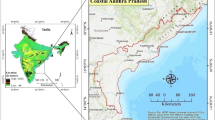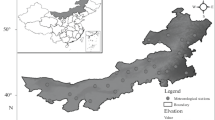Abstract
Precipitation regime and its spatial and temporal distribution are essential requirements of environmental planning. Precipitation Concentration Index (PCI) and geographical weight regression method are two practical methods for the prediction of the temporal and spatial distribution of precipitation variables. For this purpose, the precipitation regime data for 13 synoptic stations in Fars province in Iran were used since their foundation in 2014. Then, the data were interpolated using Inverse Distance Weighting (IDW) method and precipitation pixels were prepared corresponding to the Digital Elevation Model (DEM), slope and aspect. The results of the study showed that the precipitation regime of the northern, northwest, and western parts of Fars province with PCI values of 13–20 with a maximum rainfall in winter was different from that of the southern and eastern parts of the studied area. In addition, the PCI values higher than 22 (PCI > 22) in the southwestern and eastern parts of the region suggested significant changes of rainfall throughout the year. Summer is the dry season of the area, and except for a very small part of southern parts of the province, the other areas were without rainfall. The results of Geographically Weighted Regression (GWR) also indicated that the prediction of precipitation regime with topographic elements shows much better results than the Ordinary Least Squares (OLS) regression, in a way that the relationship between altitude and rainfall in the western, northwestern, and central parts of the province were positive and significant, and the areas of eastern parts of Fars province showed a negative relationship in terms of topographic elements (aspect and altitude). Finally, the results of the prediction of GWR model showed that the mentioned model was able to assess more than 80% of the existing relationship between observe and predict the monthly precipitation amount based on the studied spatial factors successfully.











Similar content being viewed by others
References
Ahmadzadeh KF (2005). Determination of mathematical model of Tabriz precipitation temporal distribution and analysis of time intervals and rainfall height by matching time series. Master’s thesis, Tabriz University, School of Agriculture
Aifeng LV, Zhou L (2016) A rainfall model based on a geographically weighted regression algorithm for rainfall estimations over the Arid Qaidam Basin in China. Remote Sens 8:311. https://doi.org/10.3390/rs8040311
Alijani B, Bayat A, Balyani Y, Doostkamian M, Javanmard A (2013) Spatial analysis of annual precipitation of Iran. In: Second International Conference On Environmental Hazard. Kharazmi University, Tehran
Asakareh H (2012) Fundamentals of statistical climatology. Zanjan University, Zanjan, p 545
Asakareh H, Seifipoor Z (2013) Spatial modeling of Iranian annual precipitation. Geogr Dev 29:15–30
Asgari A (2011) Spatial statistics analysis with ArcGIS, 1st edn. Tehran Municipality Information and Communication Technology Organization publication
Balyani S (2016) Spatial analysis of yearly precipitation of Khoozestan province, An approach of spatial regressions analysis. J Appl Geosci Res Year 16(43):125–147
Balyani Y, Doost H (2014) Fundamentals of spatial data processing using spatial analysis methods, 1st edn. Azad Peyama Publication, Iran, p 436
Balyani S, Khosravi Y, Ghadami F et al (2017) Modeling the spatial structure of annual temperature in Iran. Model Earth Syst Environ (2017) 3:581. https://doi.org/10.1007/s40808-017-0319-7
Brunsdon C, McClatchey J, Unwin DJ (2001) Spatial variation in the average rainfall–altitude relationship in Great Britain: an approach using geographically weighted regression. Int J Climatol 21:455–466
Buba LF, Kura NU, Dakagan JB (2017) Spatiotemporal trend analysis of changing rainfall characteristics in Guinea Savanna of Nigeria, Model. Earth Syst Environ 3:1081. https://doi.org/10.1007/s40808-017-0356-2
Chandrashekar VD, Shetty A, Singh BB et al (2017a) Spatio-temporal precipitation variability over Western Ghats and Coastal region of Karnataka, envisaged using high resolution observed gridded data. Model Earth Syst Environ. https://doi.org/10.1007/s40808-017-0395-8
Chandrashekar VD, Shetty A, Singh BB, Sharma S (2017b) Spatio-temporal precipitation variability over Western Ghats and Coastal region of Karnataka, envisageusing high resolution observed gridded data. Model Earth Syst Environ 3(4):1611–1625 https://doi.org/10.1007/s40808-017-0395-8
Dai X, Li D, Guo Z, Zhang L (2010) Spatio-temporal exploratory analysis of urban surface temperature fieldShanghai, China. Stoch Environ Res Risk Assess 24:247–257
De Lui’s M, Raventos J, Gonzalez-Hidalgo JC, Sanchez IR, Cortina J (2000) Spatial analysis of rainfall trends in the region of Valencia (East Spain). Int J Climatol 20:1451–1469
De Lui’s M, Garcia-Cano MF, Cortina J, Ravaentos J, Gonzales-Hidalgo JC, Sanchez JR (2001) climate trends, disturbances and short-term vegetation dynamics in a Mediterranean shrubland. For Ecol Manag 147:25–37
Gao X, Asami Y, Chung CJF (2006) An empirical evaluation of spatial regression models. Comput Geosci 32:1040–1051
Hansen J, Lebedeff S (1987) Global trend of measured surface temperature. J Geophys Res 92:13345–13372
Jahanbakhsh S, Movahed Danesh AA, Molavi, Vahed, (2001) Analysis of evapotranspiration estimates for Tabriz Weather Station, agricultural knowledge. Tabriz University, Tabriz 11, pp 51–65
Jones PD, Raper SCB, Bradley RS, Diaz F, Kelly PM, Wigley TML (1986) A Northern Hemishere surface temperature variation: 1851–1984. J Clim Appl Meteorol 25:161–175
Keshtkar H, Voigt W (2016) A spatiotemporal analysis of landscape change using an integrated Markov chain and cellular automata models. Model Earth Syst Environ https://doi.org/10.1007/s40808-015-0068-4
Mahmoodi P, Alijani B (2013) Modeling the relationship between annual and seasonal precipitation and climatic factors in Kurdistan. J Appl Geosci Res 31:93–112
Mansouri Daneshvar MR, Hussein Abadi N (2017) Spatial and temporal variation of nitrogen dioxide measurement in the Middle East within 2005–2014. Model Earth Syst Environ 3:20. https://doi.org/10.1007/s40808-017-0293-0
Masoudian A, Qayour H (2008) Spatial survey of the uniformity of temporal precipitation distribution in Iran. Geogr Res 54–55
Propastin P, Kappas M, Erasmi S (2008) Application of geographically weighted regression to investigate the impact of scale on prediction uncertainty by modelling relationship between vegetation and climate. Int J Spat Data Infrastruct Res 3:73–94
Tabatabayi H, Hosseini M (2003) Climate change study in Semnan City based on precipitation parameters, monthly average temperature, Third Regional Conference and The First National Conference on Climate Change in Isfahan
Author information
Authors and Affiliations
Corresponding author
Rights and permissions
About this article
Cite this article
Salimi, S., Balyani, S., Hosseini, S.A. et al. The prediction of spatial and temporal distribution of precipitation regime in Iran: the case of Fars province. Model. Earth Syst. Environ. 4, 565–577 (2018). https://doi.org/10.1007/s40808-018-0451-z
Received:
Accepted:
Published:
Issue Date:
DOI: https://doi.org/10.1007/s40808-018-0451-z




